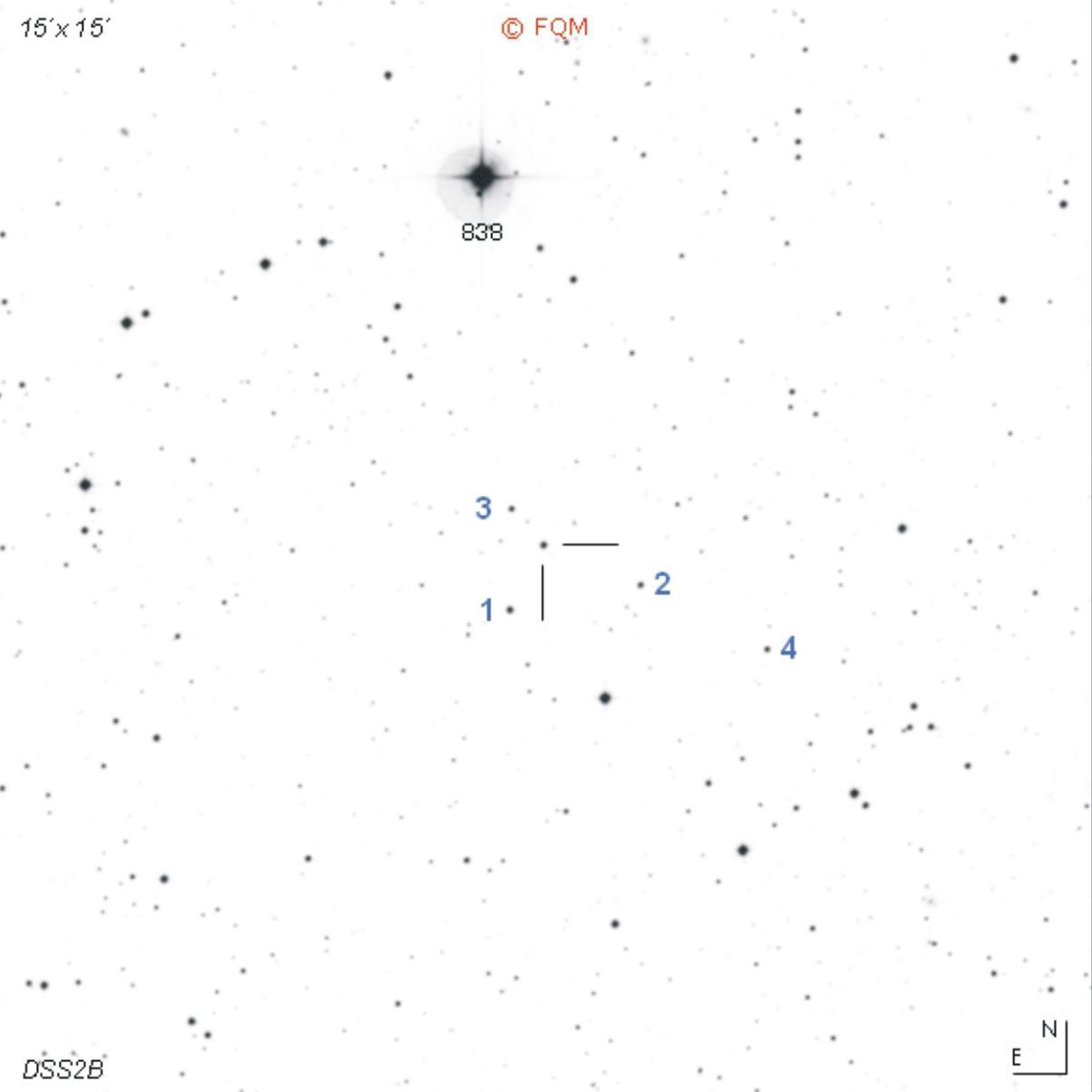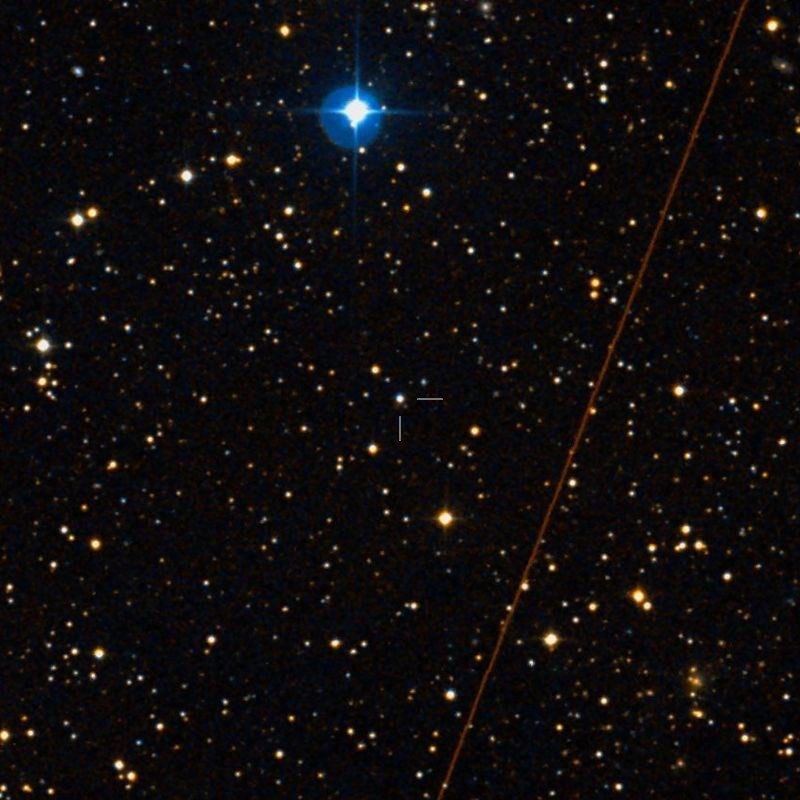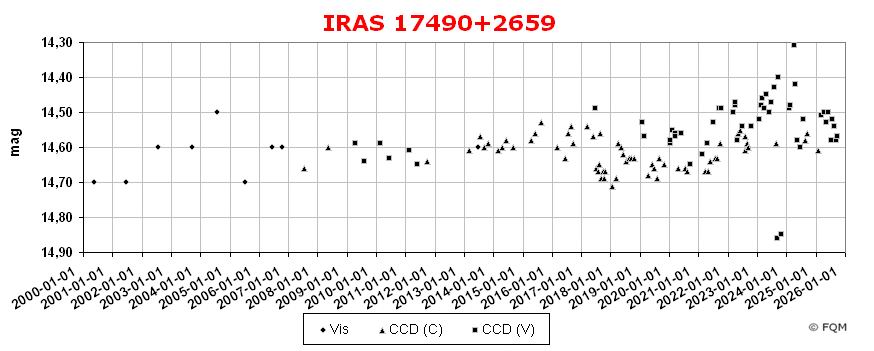
| Frankfurt Quasar Monitoring |
| IRAS 17490+2659 |
| Cross-Identifications | LEDA 97547, TXS 1749+269, GB6 B1749+2659 IRAS F17490+2659, MG3 J175105+2659 87GB 174904.5+265939, 1749+269 WISEA J175105.54+265903.2 |
| Equat. coordinates | RA 17 51 05.5 DE +26 59 02 (J2000) |
| Constellation | Hercules |
| Type | QSO |
| Redshift (1) (2) |
z=0.145 |
| Distance (2) (3) |
576 Mpc |
| Total mag range (mv) (4) | 14.3 - 15.1 |
| Catalog Magnitude | 15.8p (1) / 15.1 (2) |
| Absolute Magnitude (1) | -23.9 MB |
| Light Travel-Time (2) | 1.757 × 109 yrs |

Comparison stars
| star | B | V | R |
| 1 | 14.71 | 14.14 | 13.94 |
| 2 | 15.37 | 14.55 | 13.82 |
| 3 | 15.51 | 14.78 | 14.16 |
| 4 | 15.53 | 15.03 | 14.49 |


| IRAS 17490+2659
is a bright quasar in the south-east of the constellation Hercules, right next to the
eastern "leg" of Hercules. This
object was discovered as
a radio source by the Texas Radio
Survey (TXS) during four observing campaigns between 1977 and 1982.
Other radio surveys have
cataloged this object as well (MG3, 87GB).
The designation IRAS 17490+2659
refers to the infrared survey run by the IRAS
satellite, where this object
was identified as an infrared source in 1983. The
source of both radio and infrared radiation was soon identified
with the very compact galaxy LEDA 97547. Spectroscopic
investigations of
the host galaxy (LEDA) of 1749+269 were
carried out in 1988 by the 2.5-m
Isaac Newton
Telescope at La Palma. A Seyfert 1.0-spectrum was found, which led to
the quasar classification in 1996. The apparent brightness was found to
be 15.1 mag in the
visual. Quasar IRAS 17490+2659 is a small amplitude variable object with a total range of only about 1 magnitude (14.3 - 15.1 mv). CCD observers, as well as visual observers, may use the comparison stars given above. No photometric sequence has been published to date. Quasar IRAS 17490+2659 is located in the eastern "leg" of Hercules, only 1.2° SE of Mu Her (86 Her). Visual observers need at least an 8- to 10-inch telescope or larger to glimpse this stellar object. Even with large instruments, IRAS 17490+2659 remains stellar. ____________
The Milky Way is not far to the east, which is peppered with bright deep sky objects. However, the area close to IRAS:17490+2659 has only faint distant galaxies to offer. One example is NGC 6482, a 12.3-mag elliptical, some 4° to the south. On the contrary, Mu Her (86 Her) is a nice double star only 1.2° NW. The 3.4-mag yellow primary has a 10.1-mag reddish companion, separated by 34". To stay with deep sky objects in the constellation Hercules, do not forget about the globular trio M13, M92 and NGC 6229, all in the northern part of the Strongman. Observers who like to visit another relatively nearby quasi-stellar object may turn to MRK 501, a very bright 13-mag BL Lac object at a distance of 440 million light-years, some 17.4° NE. |
| Condon, J.J., Anderson, E., et al. 1995, AJ, 109, 2318; Radio Identifications of Extragalactic IRAS Sources. de Grijp, M.H.K., Keel, K.C., et al. 1992, A&AS, 96, 389; Warm IRAS sources. II. Optical spectroscopy of objects from the point source catalog. de Grijp, M.H.K., Miley, G.K., et al. 1987, A&AS, 70, 95; Warm IRAS sources - A catalogue of AGN candidates from the point source catalogue (PSC). Douglas, J.N., Bash, F.N., et al. 1996, AJ, 111, 1945; The Texas Survey of Radio Sources Covering -35.5° < declination < 71.5° at 365 MHz. Griffith, M., Langston, G., et al. 1990, ApJS, 74, 129; The third MIT-Green Bank 5 GHz survey. Karge, S.; Helle Quasare für 8- bis 10-Zoll Teleskope. Ein Beobachtungsführer zur visuellen Beobachtung von Quasaren und BL Lacertae Objekten; Frankfurt 2005. Véron-Cetty, M.-P., Véron, P., 1996, ESO Scientific Report 17; A Catalogue of Quasars and Active Nuclei (7th Edition) Véron-Cetty, M.-P., Véron, P. 2001, A&A 374, 92; A Catalogue of Quasars and Active Nuclei: 10th edition. Véron-Cetty, M.-P., Véron, P. 2003, A&A 412, 399; A Catalogue of Quasars and Active Nuclei: 11th edition. Véron-Cetty, M.-P., Véron, P. 2006, A&A 455, 776; A Catalogue of Quasars and Active Nuclei: 12th edition. Véron-Cetty, M.-P., Véron, P. 2010, A&A 518, 10; A Catalogue of Quasars and Active Nuclei: 13th edition. |
| home |